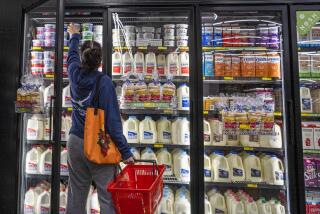Food Replaces Oil in Fueling 0.4% Jump in Wholesale Prices
- Share via
WASHINGTON — Wholesale prices, driven by the first surge in food costs in five months, jumped 0.4% in March, the government said today. Energy costs, after dramatic gains in January and February, began leveling off.
The 0.4% increase falls between the 0.6% jump recorded in January and the 0.1% rise in February. Together they show the inflation rate for wholesale goods ran in the first quarter of 1987 at a seasonally adjusted annual rate of 4.6%, the Bureau of Labor Statistics said.
Not all wholesale price rises are passed on to consumers. Nevertheless, today’s report should bolster predictions that Americans will see the inflation rate this year reach 3.5% to 4% after having enjoyed a mere 1.1% increase in prices last year.
March’s Producer Price Index showed that the cost of processed energy goods--mainly gasoline, fuel oil and natural gas--dropped 0.2% after having risen 10% in January and 4% in February. Meanwhile, food prices went up 0.5% after having fallen the previous four months.
Gasoline prices at wholesale rose 0.4% in March and fuel oil costs were up 0.1%. Gasoline costs had risen 15.7% in January and 5.5% in February while heating oil costs had spurted more than 21% over those two months.
In the food category, pork prices rose 1.1%, fresh fruit and bakery prices jumped 0.7% and soft drink prices were up 0.5%.
Coffee prices, however, fell 2.3% and are now 17% under the levels of a year ago.
Other Steep Increases
Prices for consumer goods other than food and energy rose at a considerably steeper pace in March than they had in most recent months. Women’s clothing costs were up 1%, while prices for prescription drugs rose 1.1%, cosmetic prices gained 1.7% and home electronic prices advanced 1.6%.
Wholesale prices for household appliances, however, held flat and automobile prices dropped 0.8%, following a 3.4% February decline, as manufacturers continued to offer rebates.
One analyst, Michael K. Evans, said beforehand that new car “dealers still have huge inventories--and even the foreign dealers are beginning to have them.”
“They all made a lot of enemies when they jacked up the prices a couple of years ago, and now they’re going to have to eat a lot of crow before they can move those cars,” Evans said.
As for the food price gains, Thomas Megan, a Washington economist, said that such costs are often volatile in March. This year, he said, unusually mild winter weather in much of the country in January and February kept production levels high and prices low.
Cows, Pigs at Market High
Megan pointed to the largely snowless winter in the Midwest, which had kept the number of cows and pigs going to market high.
Thus, the seasonal adjustment process, normally reflective of stepped-up March production following months of depressed activity, may have overstated price changes last month.
As for the balance of the year, he said, “Food is not going to be a key area on the inflation front. We expect it to be up somewhat over the year, but not at more than an annual rate of 2.5%.”
Wholesale prices dropped 2.5% in 1986, the biggest decrease since 1949, largely because of plummeting oil prices early in the year.
More to Read
Inside the business of entertainment
The Wide Shot brings you news, analysis and insights on everything from streaming wars to production — and what it all means for the future.
You may occasionally receive promotional content from the Los Angeles Times.










